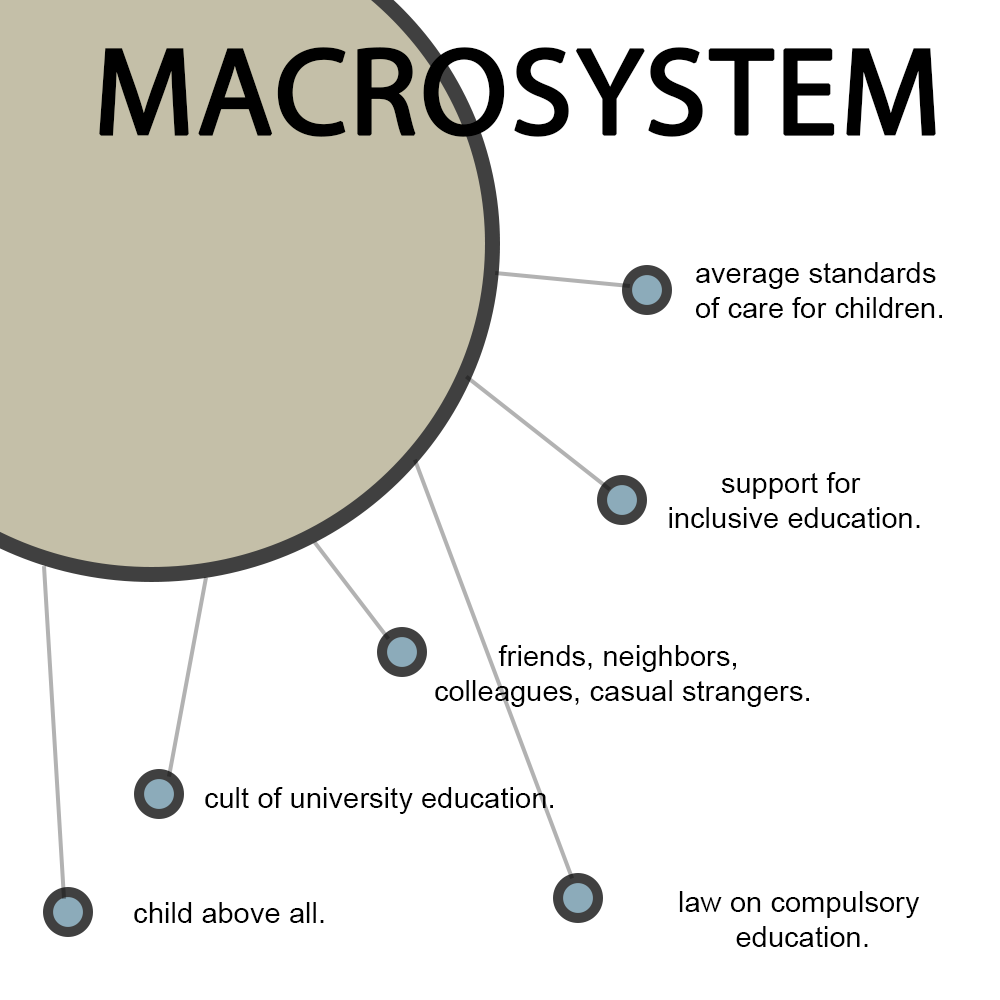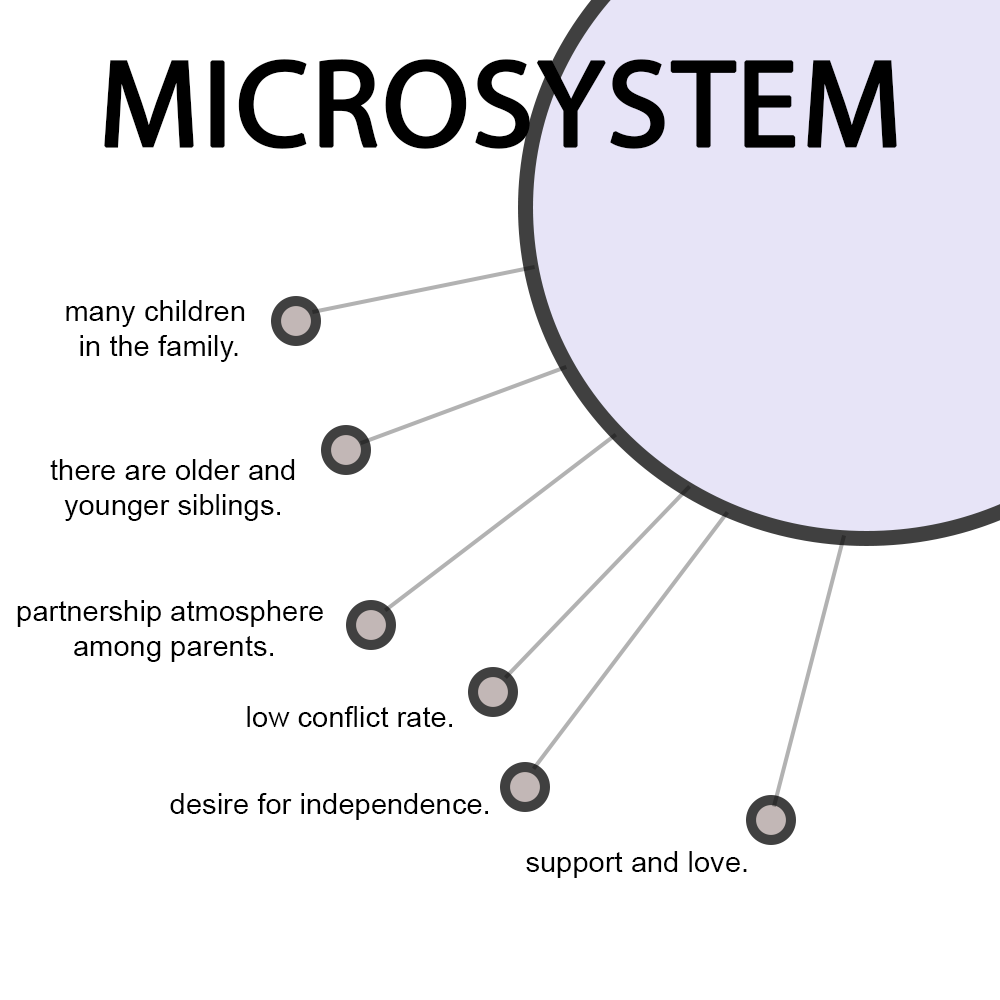
Brief description of Figure 1. The first Bronfenbrenner’s ecosystem selected is the macroecosystem, the largest structural unit within the theory. As elements of this model, the author’s environment’s fundamental values, prejudices, and mentalities characteristics were chosen. If to evaluate this macrosystem as a whole, there are principles of caring for children, supporting them, and creating an environment in which they could develop harmoniously. Although closer to adulthood, children are expected to make serious choices that have the potential to affect their lives.
Visualization of the second Bronfenbrenner’s ecosystem

Brief description of Figure 2. The second ecosystem is the environment in which the child is brought up. In particular, the minimum unit of the theory was chosen, namely the microsystem, or family system. It can be estimated that the principal determinants of influence on the seven-year-old child are the family structure (number of siblings, presence of two parents), the type of relationships between parents, and the fundamental values of the family.
Summary
For the teacher, researching factors that directly or indirectly affect a child’s development is a primary goal aimed at establishing a positive relationship with the student and finding vulnerable categories. Taking into account the age, personality, and family characteristics of children, usually dictated by external environments, is necessary to maximize the impact of educational activities (“A teacher’s role,” 2017). It depends on how comfortable a child will feel in their development.
In fact, collecting additional information about students is of particular importance and is aimed at meeting two educational needs at once. First of all, a teacher who has learned the main determinants of influence on their student can more easily find an individual approach to learning (Davies, 2019). For instance, if Eastern values are popular in a child’s family, where interaction and cooperation are at the heart of learning, then the teacher may offer the child group lessons. On the other hand, children whose parents are in constant conflict are under constant stress, so the teacher can help the child to integrate more firmly into the learning process so that they do not fall into depressive feelings.
The second task, which is to collect information about pupils, is to identify hazards. It must be recognized that the modern world is not always child-friendly, and the negative influence of dishonest friends, problems in the family, the inconsistency of personal and social norms can become severe problems for the harmonious development of a child both in an academic and personal context. For illustration, the social environment, the mesosystem, can encourage hooliganism or drug use, which is a sufficient argument for emergency assistance to the child (Hertler et al., 2018). In other words, it means that the teacher can explore the student’s environment, from microsystems to macrosystems, to find the main problems for learning. By identifying them, the teacher can work on the problem with the pupil and draw the attention of parents, the school’s psychological support services, and the principal to the identified threats.
Moreover, cultural ones have a direct impact on the child, too: language, religion, mentality, and values become the main reference points for the pupil’s learning. This phenomenon generates a choice of environments in which a teacher can work with children. In particular, the author of this paper was not against educating children whose native language is not English and who came from other countries to study the environment and culture. This choice is determined by the thinking patterns of students who have changed their environment: it is usually a synthesis of different opinions, ideas, and values that prevent prejudices and social stereotypes from becoming entrenched. In these classes, children are more patient with each other because they understand how difficult it can be to integrate into the academic environment.
It is fair to say that analyzing the components of a child’s growing environment should be some tradeoff between a student’s personal space and their objective safety. It is unlikely that a child doing something forbidden and socially reprehensible will tell the teacher about it. Instead of coercion, the educator should create an environment of friendliness and support where the child feels absolutely safe and can help the student (Morin, 2020). Moreover, the level of information that becomes known during the analysis is determined only by the pupil. It usually includes family structure, support or lack of support from parents, hobbies, inner thoughts and feelings, and friends.
References
Davies, T. (2019). Why is it so important for teachers to understand Child Development? Fagus. Web.
Hertler, S. C., Figueredo, A. J., Peñaherrera-Aguirre, M., & Fernandes, H. B. (2018). Urie Bronfenbrenner: Toward an evolutionary ecological systems theory. Life History Evolution, 1(1), pp. 323-339.
Morin, A. (2020). 5 things parents need to discuss with a child’s teacher. Verywell Family. Web.
A teacher’s role, view of the child and role of families. (2017). Experience. Web.